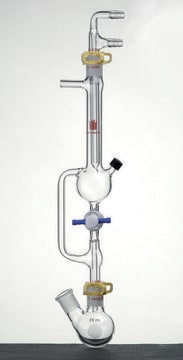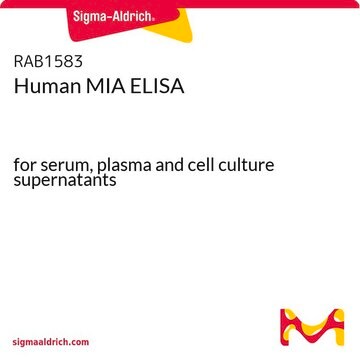11976826001
Roche
MIA ELISA
sufficient for ≤96 tests, Roche, kit of 1 (9 components), suitable for ELISA
Sinônimo(s):
ELISA
About This Item
Produtos recomendados
uso
sufficient for ≤96 tests
Nível de qualidade
embalagem
kit of 1 (9 components)
fabricante/nome comercial
Roche
técnica(s)
ELISA: suitable
temperatura de armazenamento
2-8°C
Descrição geral
Standards: Six standards, ranging from 0 to 50 ng/ml MIA protein, are provided with lot-specific data.
Especificidade
Imunogênio
The antibodies recognize non-overlapping epitopes, which are conformational epitopes (no linear sequence is recognized but rather parts of 3D-conformation). Exact epitopes have not been determined.
Aplicação
The MIA ELISA is an ideal application in research studies determining the melanoma inhibitory activity protein in serum and plasma.
The MIA ELISA is specially developed for the quantitative in vitro determination of MIA protein in serum and plasma within streptavidin-coated microplates (MPs). It has a wide applictaion in MIA (melanoma inhibitory activity) ELISA assays.[1]
Embalagem
Nota de preparo
- Anti-MIA-Biotin: Reconstitute the lyophilizate in 0.7 ml double-dist. water for 10 minutes at 15 to 25 °C and mix thoroughly. Do not vortex.
Result: A clear, colorless solution. - Anti-MIA-Peroxidase: Reconstitute the lyophilizate in 0.7 ml double-dist. water for 10 minutes at 15 to 25 °C, and mix thoroughly. Do not vortex.
Result: A clear, slightly yellowish solution. - MIA Standard: Reconstitute the lyophilizate in 0.5 ml double-dist. water for 10 minutes at
15 to 25 °C, and mix thoroughly.Do not vortex.
Result: A clear, colorless solution. Concentration indicated on the label. - MIA Control Serum: Reconstitute the lyophilizate in 0.3 ml double-dist. water for 10 minutes at 15 to 25 °C, and mix thoroughly. Do not vortex.
Result: A Slightly opalescent and yellowish solution. Concentration indicated on the label. - Washing Buffer : Dissolve one tablet in 2 l of double-dist. water.
Result: A clear, colorless solution. - Immunoreagent: For 8 wells (1.8 ml): Add 50 μl reconstituted anti-MIA-Peroxidase (solution 2) to 1.7 ml Incubation Buffer, and mix well. Then add 50 μl of anti-MIA-biotin
(solution 1), and mix thoroughly. Do not vortex.
Result: A clear, colorless solution.
Roche recommends using only double distilled water for the reconstitution of lyophylizates.
Storage conditions (working solution): Anti-MIA-Biotin (vial 1):
6 months at -15 to -25 °C or ≤ -60 °C when aliquoted and shock-frozen
Anti-MIA-Peroxidase (vial 2):
6 months at -15 to -25 °C or ≤ -60 °C when aliquoted and shock-frozen
MIA-Standard (vial 3):
1 day at 2 to 8 °C or 6 months at -15 to -25 °C or ≤ -60 °C when aliquoted and shock-frozen
MIA-Control Serum (vial 4):
1 day at 2 to 8 °C or 6 months at -15 to -25 °C or ≤ -60 °C when aliquoted and shock-frozen
Washing Buffer (vial 6): 1month at 2 to 8 °C
Immunoreagent: 8 hours at 2 to 8 °C
Somente componentes do kit
- Anti-MIA-biotin antibody, monoclonal from mouse, lyophilized (clone 2.F7.3B1)
- Anti-MIA-peroxidase antibody, monoclonal from mouse, lyophilized (clone 1.A12.9A1)
- MIA Standard, lyophilized
- MIA Control Serum, MIA in human serum, lyophilized approximately 25 ng/ml
- Incubation Buffer ready-to-use
- Washing Buffer
- ABTS Substrate Solution ready-to-use
- Streptavidin-coated Microplate modules
- Self-adhesive Plate Cover Foils
Palavra indicadora
Warning
Frases de perigo
Declarações de precaução
Classificações de perigo
Aquatic Chronic 3 - Skin Sens. 1
Código de classe de armazenamento
12 - Non Combustible Liquids
Classe de risco de água (WGK)
WGK 3
Ponto de fulgor (°F)
does not flash
Ponto de fulgor (°C)
does not flash
Escolha uma das versões mais recentes:
Já possui este produto?
Encontre a documentação dos produtos que você adquiriu recentemente na biblioteca de documentos.
Nossa equipe de cientistas tem experiência em todas as áreas de pesquisa, incluindo Life Sciences, ciência de materiais, síntese química, cromatografia, química analítica e muitas outras.
Entre em contato com a assistência técnica









